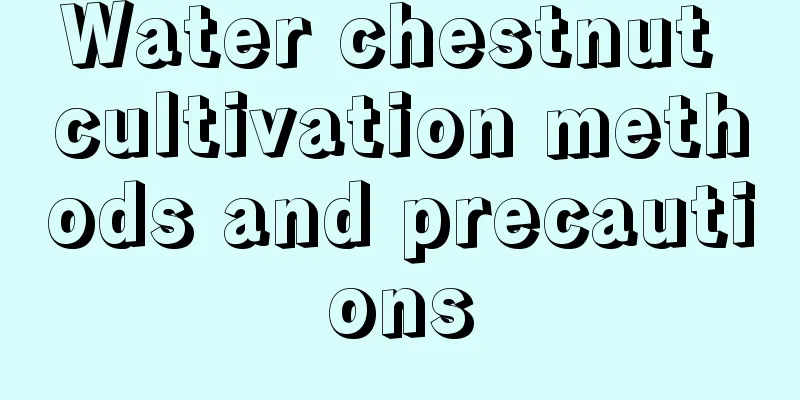Water chestnut cultivation methods and precautions

1. Maintenance methods1. Soil: Water chestnuts do not have very high requirements for soil and can grow well in most soils. The soil can be prepared by mixing garden soil and a small amount of fine sand. Note that the soil should not be too sticky, which will affect the taste of the bulb. 2. Light: It needs to grow in a place with good lighting to meet the growth needs of the bulb. You can usually place it in a place with good lighting conditions such as a balcony to avoid long periods of time without sunlight. 3. Temperature: A warm environment is more suitable for its growth. The normal breeding temperature can be kept at around 20℃. It is very afraid of cold. Try to move it indoors for maintenance in winter and pay attention to cold prevention. 4. Water: It likes a humid growing environment, and many of them are planted in paddy fields or ponds, so try to provide it with sufficient water during breeding, especially in the hot summer weather, to ensure that it has sufficient water. 2. Breeding techniques1. Reproduction: Water chestnuts are generally propagated by their bulbs. Select bulbs of good quality and weighing more than 15 grams, soak them in carbendazim for sterilization, and then germinate them indoors, after which they can be sown. 2. Germination: Germination is usually done indoors. Spread 10 cm of straw, arrange the water chestnut buds on it facing upwards, spread another layer of straw on top, put the water chestnuts on it, repeat three or four layers, wet it with water every day, keep it moist, and when the buds grow to about 4 cm, they can be planted. 3. Problem diagnosis and treatment1. Disease: Stem rot is the most harmful to it. This disease is more likely to occur in hot and humid weather, and the speed of onset is very fast. If it is discovered late, the whole bead is beyond saving. In the early stage, you can spray it with 500-1000 times of 50% carbendazim. 2. Pests: Common ones are borers, grasshoppers, etc. Pests do not cause much harm to it. Just catch and kill them in time when you find them, or use omethoate for prevention and control. IV. Other issues1. Can it be eaten: Water chestnuts are edible and can be cooked with many ingredients, but please note that it is a cold food and women during menstruation should not eat it. 2. Is it poisonous? Water chestnuts are non-toxic, and their bulbs are edible. They taste very good after being cooked, so they can be safely cultivated and eaten. |
<<: Brussels sprouts cultivation methods and precautions
>>: Cultivation methods and precautions of the string money vine
Recommend
What is the best fertilizer for sunflowers?
Sunflower fertilization time Sunflowers require s...
How to trim mirror grass to make it look good
1. Daily pruning 1. Withered and yellow leaves: I...
Peach tree management technology in July
July is a month of high humidity and temperature,...
What is the best soil for Clivia and how to configure the soil
1. What kind of soil is best? 1. Leaf mold: The m...
Does Fuchsia like the sun?
Fuchsia likes the sun Fuchsia is a plant that lik...
How to fertilize lily bamboo
Specific fertilization method: In fact, lily bamb...
How to prune azalea
When to prune azalea Rhododendrons are usually sh...
How to fertilize basil
How to fertilize basil: In fact, basil does not n...
Taboos on the placement of lucky bamboo
1. Wealth Position Although lucky bamboo is very ...
What trees are suitable for planting in the desert? What trees are suitable for planting in the desert?
Trees planted in the desert cannot be planted ran...
What should be paid attention to in grafting to ensure the survival rate (key measures and precautions for grafting)
Grafting is a commonly used propagation method fo...
How long does it take to pot the succulent after root pruning?
1. How long to pot after root pruning? Generally,...
How to prune branches and leaves of Schefflera chinensis? Pruning and shaping methods (pictures)
Schefflera is suitable for pruning in winter. Aft...
The efficacy and function of iris
The ornamental and economic value of Iris Iris is...
How to prune Dendrobium
When to prune Dendrobium According to the growth ...









